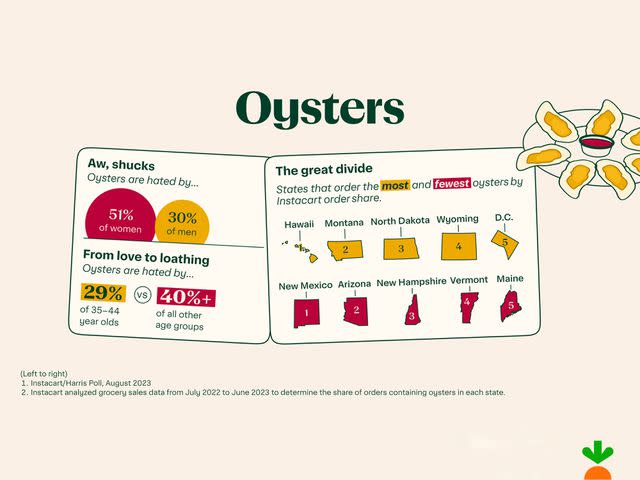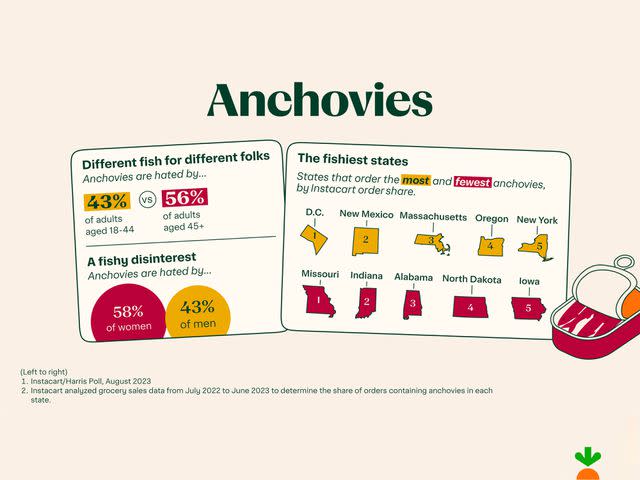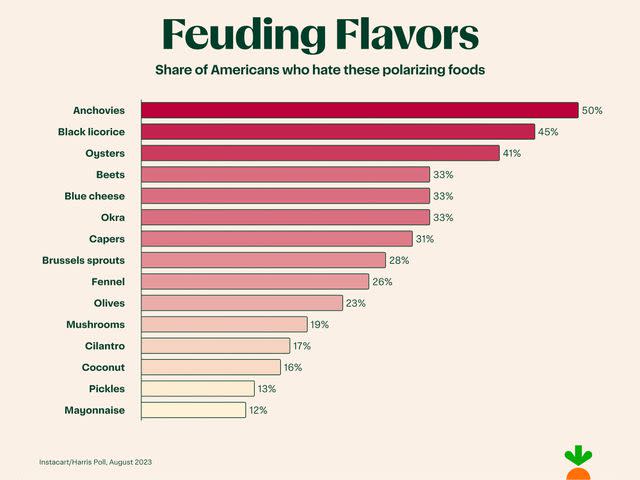The Most Hated Foods in America, According to Grocery Shopping Data
Of course, you might love them—we sure do!

Adobe Stock/Allrecipes
In the United States, culinary preferences are as diverse as the nation itself. We all have strong opinions, from the best recipe for chocolate chip cookies to our favorite store-bought products. We have ingredients we love, and those we steer clear of, making substitutions or skipping altogether. And some foods leave no room for a middle ground.
But what are the most divisive and where do you land on the side of love or hate? Instacart purchase data, along with a Harris Poll survey, is giving us new insight, plus cold hard facts on a roundup of polarizing ingredients you can bring with you to your next food fight.
The Top 3 Most Divisive Foods in the U.S.
#3 Oysters

Instacart
There is something festive and celebratory about enjoying raw oysters from an ice-packed tray at happy hour or grabbing decadent Oysters Rockefeller from an appetizer platter. But apparently, they're not for everyone. 41% of shoppers won't be shucking oysters anytime soon. And to them we say, more for us! Interestingly enough, Instacart purchase data also reveals that three of the top five states that order the most oysters are completely landlocked–including Montana, North Dakota, and Wyoming.
#2 Black Licorice

Instacart
45% of shoppers say no to black licorice. Though it's surprising to see a sweet treat in the top three, if it's going to be anything, it makes sense that it's the strong, sticky, anise-flavored candy. It seems black licorice has a generational divide: 48% of Americans aged 18-54 hate black licorice, while only 37% of Americans 65 and older share the same sentiment.
#1 Anchovies

Instacart
You might have had a guess that popped into your head right away. If you thought "anchovies!" you hit the mark. According to the survey, 50% of people can't stand these flavor-packed fish, making them the most divisive on the list. Further, 58% of women and 43% of men fervently opt out of anchovies on their pizzas and Caesar salads. Though we at Allrecipes know that anchovy is an often misunderstood ingredient with a big umami punch. Use it as a secret component for extra flavor in classic dishes and no one will be the wiser...until they ask you for the recipe. Shoppers in D.C., New Mexico, Massachusetts, Oregon, and New York are already with us.
A Full List of the Top Most Hated Ingredients in the U.S.

Instacart
After the top three, the following foods round out the rest of the controversial grocery picks:
Beets: These earthy root vegetables are hated by 33% of shoppers (but by our math, that means they are loved by 77%—especially in these recipes—and we're glass-half-full people).
Blue Cheese: Also hated by 33% of people, "moldy cheese" was bound for this roundup as it's definitely divisive. But we can't imagine a wedge salad without its signature rich and creamy dressing.
Okra: Because of the somewhat slimy consistency okra can develop when cooked, 33% of survey participants find this vegetable off-putting. Maybe they should try frying it. The rest of us savor the earthy flavor and the thickening quality it lends to dishes like gumbo.
Capers: These small, briny buds are loved by many for their unique tanginess, but can be overpowering for 31% of Americans surveyed. Capers may just be an acquired taste, so test their piquant punch in a roundup of favorite recipes here.
Brussels Sprouts: If you are among the 28% that despise boring ol' Brussels sprouts, perhaps you have the wrong idea. Let us fix that with these dishes that will change your mind.
Fennel: Since black licorice is on the list, we figured we would see fennel too. But this more mellow anise-flavored veg and seed is only disliked by 26% of people. Fennel is a beautiful addition to many easy sides and main dishes, known for its aromatic flavor and crisp texture.
Olives: The sharp, salty taste of olives turns off 23% of survey participants but the rest of us relish this iconic ingredient as an essential part of charcuterie boards, family recipes, and the classic dirty martini.
Mushrooms: Could be the texture, could be the earthy flavor, but 19% of people aren't mushroom fans. (Or maybe they're cooking them wrong!) We're glad to know the other 81% appreciate the deep, savory taste and versatility these fungi provide.
Cilantro: We've talked about cilantro's unique, grassy, some say soap-like taste before so no big shock to see it here again, with 17% of people hating it. On the flip side, it's currently the most popular herb in the country as well.
Coconut: 16% of shoppers just don't love the sweet, nutty flavor coconut offers. Coconut stans, we've got you covered.
Pickles: Being hated by only 13% of Americans is kind of impressive for crunchy, tangy, pungent pickles. This divisive food has its place in sandwiches, salads, or just as a snack—but some just pass on the pucker.
Mayonnaise: Should being hated by only 12% of people even count? We love our mayo and appreciate all the versatile ways we can use it. So do the other 88% of shoppers surveyed. But we know it's not everyone's go-to. They must be grabbing Miracle Whip instead.
Why Are These Foods So Polarizing?
“While the list of divisive foods is long, let’s focus on the top three hated foods—anchovies, black licorice, and oysters—and what makes each seemingly controversial for American palates. Anchovies possess a briny, fishy flavor profile, oysters give off a super slimy mouthfeel, and licorice shocks the tongue with an unmissable anise and fennel flavor. On top of that, they all present chewy textures that can prove challenging for certain people. The complex interplay of these unique flavors and textures is likely why they’re at the top of the list, and it’s also the reason we’re not seeing foods like white bread show up” says Laurentia Romaniuk, Instacart’s Trends Expert.
The top reasons Americans think a food could be polarizing or controversial include:
Smell (66%)
Strong flavor (57%)
Texture (57%)
Visual appearance (47%)
Type of flavor, i.e. sweet, sour, salty (47%)
How it makes you feel after eating it (32%)
To break things down further, Romaniuk added “We found it interesting that women seem to have a much stronger dislike for anchovies, black licorice, and oysters compared to men across the board. This could be because women have less tolerance for smell, strong flavor, and texture–the top three reasons why Americans think a food could be polarizing or controversial.”
The silver lining here is that nearly 7 in 10 Americans (69%) say they have encountered a food that they initially disliked but eventually grew to enjoy and 37% of Americans say they are eager to try new foods that have a divisive reputation. So we have hope! (And countless recipes for inspiration, of course.)
Instacart's Survey Method
After researching some of the most polarizing foods, Instacart created a list of the top contenders and then commissioned a survey conducted online by The Harris Poll. Within the survey, Americans were asked which of those foods they hated. This survey was conducted online from August 3-7, 2023, among 2,032 adults ages 18 and older.
Read the original article on All Recipes.

